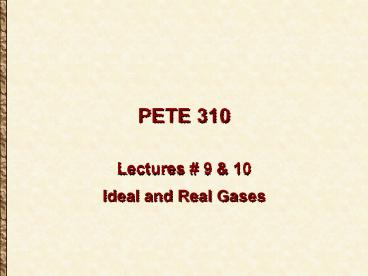PETE 310 - PowerPoint PPT Presentation
1 / 31
Title:
PETE 310
Description:
PETE 310 Lectures # 9 & 10 Ideal and Real Gases Equations of State The Ideal Gas Ideal gas properties Volume of gas molecules is negligible compared with gas volume ... – PowerPoint PPT presentation
Number of Views:68
Avg rating:3.0/5.0
Title: PETE 310
1
PETE 310
- Lectures 9 10
- Ideal and Real Gases
2
Equations of State The Ideal Gas
- Ideal gas properties
- Volume of gas molecules is negligible compared
with gas volume - Forces of attraction or repulsion between
molecules or walls of container are zero - No loss of internal energy due to collisions
3
Boyles Law
At fixed T
V
Gay Lussacs Law
At fixed P
4
Avogadros Law
At the same P and T equal Volumes of gas
contain the same of molecules Na 2. 73X1026
molecules/lb mole
5
Internet Lesson on Ideal Gas Behavior
- Experimental instructions
- Problems with solutions
http//jersey.uoregon.edu/vlab/Piston/
Hi, I am Boyle
http//dbhs.wvusd.k12.ca.us/GasLaw/WS-Ideal.html
6
Ideal Equation of State Construction
7
Boyle Charles laws
Charles
Boyle
a cool website with lots of info
http//dbhs.wvusd.k12.ca.us/GasLaw/KMT-Gas-Laws.ht
ml
8
Boyle Charles laws
R gas constant, depends upon units used See
page 95 McCain book
9
Ideal Gas Mixture
- The pressure in a vessel containing an ideal gas
mixture (n) or a single gas component (nk) is
http//home.a-city.de/walter.fendt/phe/gaslaw.htm
10
Partial Pressure
- Pk is the partial pressure of component k, and by
definition
11
Density of ideal gas
Watch out the units!
12
Mixtures of Ideal Gases
- Daltons law of partial pressures
- Amagats law of partial volumes
- Specific gravity of a gas
13
Apparent Molecular Weight of a Gas Mixture
- Determine the Mwa and density of a mixture of
30C1, 40C2, and 30C3 at T200oF and P4000
psia
14
Behavior of Real Gases
15
Equations of State for Gases
- Ideal gas
- Real gas
Z is the ratio of the real molar volume over
the ideal molar volume of a substance measured
at the same pressure and temperature.
16
Compressibility Factor Charts
17
The Principle of Corresponding States
All fluids when compared at the same reduced
temperature and reduced pressure, have
approximately the same compressibility factor,
and all deviate from ideal gas behavior to about
the same degree
The Principle of Corresponding states (POC)
originated with single component fluids.
18
Typical Reduced Parameters
- Material properties are usually expressed in
terms of reduced parameters such as - Reduced Temperature
19
Typical Reduced Parameters
- Reduced Pressure
- Reduced Molar Volume
20
Reduced Parameters
- Usually Tr and Pr ? Vr obtained as a function of
Tr and Pr - These are called two-parameter Corresponding
States models - Three-parameter corresponding states models
improve predictions but third parameter is not Vr
(not independent variable)
21
Generalized Corresponding States Three-Parameter
- This third parameter is called the acentric
factor. - It takes into account the non-spherical nature of
molecules - Peng Robinson and the Soave Redlich Kwong
equations of state (EOS) are examples of three
parameter corresponding states models.
22
Compressibility Factor Charts
- Following the POC only one compressibility factor
chart can be used to determine volumetric
properties of any pure fluid by using its reduced
properties. The shape of this chart is in
general.
23
Corresponding States Correlations Models
- The objective is then to find a model (models) to
predict the Z factor. - Ideal gas behavior is described from the ideal
gas Equation of State (EOS) with a
compressibility factor of 1.
24
Extension of Corresponding States to Mixtures
- Z factor charts (all built from EOS) are also
used for multicomponent systems in this case the
coordinates used are pseudo-reduced properties - For a mixture you can use the same charts as for
a pure component.
25
Pseudoreduced Properties
- For mixtures the same type of charts apply but
using pseudoreduced properties which are
defined similarly as the ratio of pressure (or
temperature) with pseudoreduced critical
pressure" (or temperature). These pseudocritical
properties are an average of the critical
properties of the components in the mixture.
Charts for mixtures can also be used for single
component fluids.
26
Compressibility factor Z as a function or
pseudoreduced pressure
27
Pseudocritical Properties of Natural Gases
- Pseudoreduced Pressure
- Pseudoreduced Temperature
28
Pseudocritical Properties of Natural Gases
- If only the specific gravity and Mw of of the
gases is known then charts are available to
estimate these pseudocritical properties (McCain
figure 3-10 ).
29
Pseudocritical Properties of Natural Gases
- Naturally the degree of accuracy is reduced
substantially. We well see methods when
compositional information is available, in this
case
30
Pseudocritical Properties of Natural Gases
- Once Z is evaluated you can find the gas density
as
31
Z-factor chart for low reduced pressures































